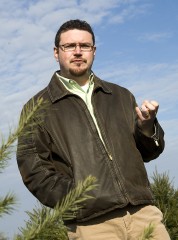Dec 3 2009
Going ‘green’ for the first time this Christmas? Climate change expert Clint Springer, Ph.D., of Saint Joseph’s University in Philadelphia, suggests live trees are a great way to begin. “From start to finish, this one choice has an effect that reaches far beyond your living room,” says Springer, a botanist and assistant professor of biology.
 Climate change expert Clint Springer
Climate change expert Clint Springer
Although some people consider farm-raised trees wasteful and potentially harmful to the environment, given that they are enjoyed for a brief time before a trip to the curb for trash pick-up after the festivities, Springer says the opposite is true.
“For the sustainable consumer, a live Christmas tree is preferable to artificial,” he says. “An expenditure on a live tree results in a carbon-neutral purchase that poses very little threat to the environment.”
Conversely, producing an artificial tree requires an increased use of resources, especially those that are non-renewable, such as petroleum, and also causes the release of harmful greenhouse gases during their production, processing and shipping. “Another huge drawback to fake trees is that eventually, they will end up in a landfill where they will linger in the environment forever, whereas live trees are recycled and made into mulch,” Springer explains.
In addition, Springer says, farmers commonly plant saplings to replace trees sold for the holiday season harvest, which culminates in nearly a zero net exchange of greenhouse gases over the life of each purchased tree.
Springer says the choice to go live is also a boon to the domestic economy: the industry brings in over $500 million annually, according to the U.S. Census Bureau. “Pennsylvania, for example, boasts more Christmas tree farms than any other state, while most artificial trees are produced in China.”
Springer studies the effect of increased levels of carbon dioxide on the flowering time of plants.